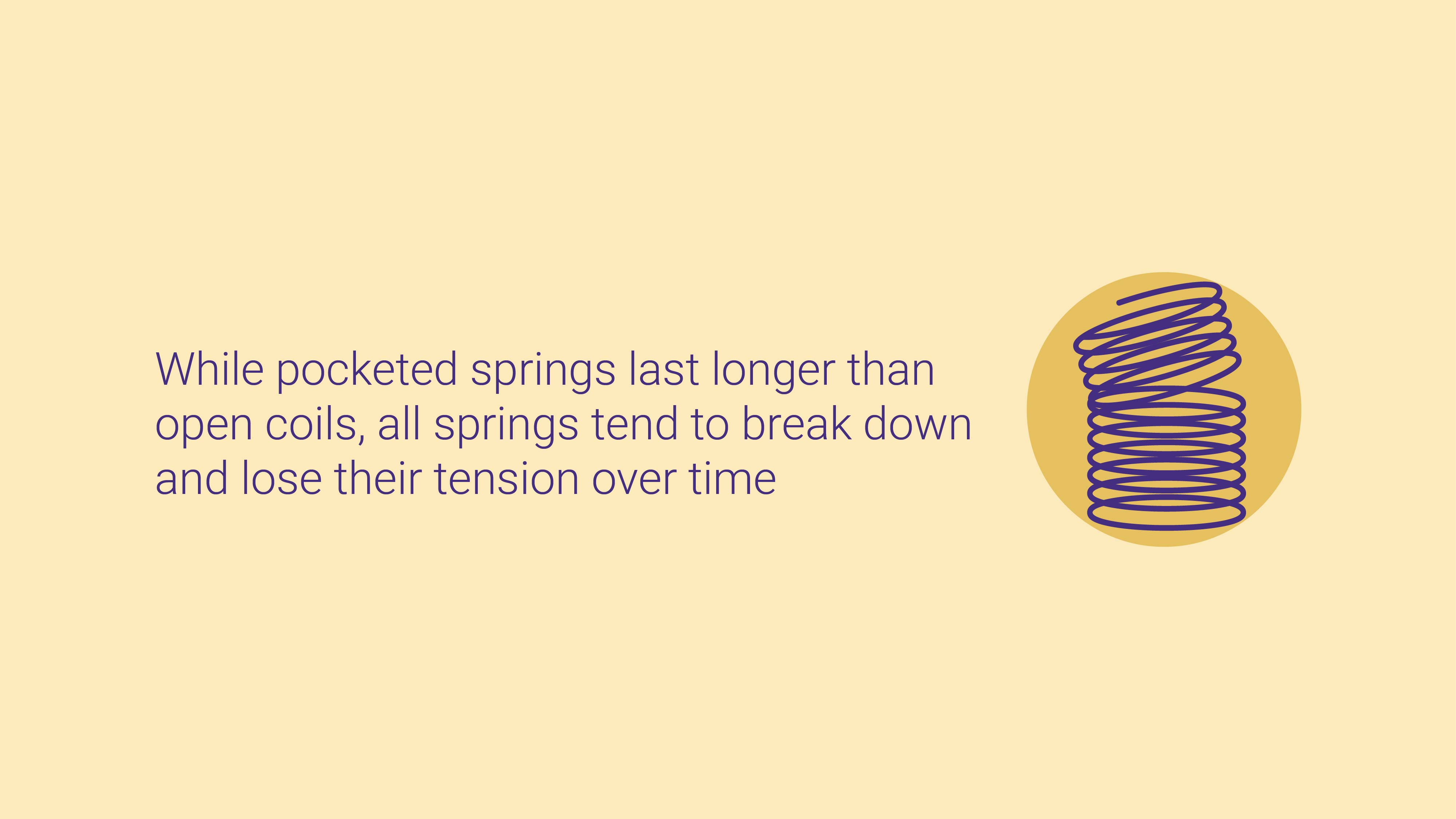
How Long Does a Latex Mattress Last

- All mattresses have a finite lifespan, and their durability varies based on factors like quality and mattress type. While some mattresses may last only five or six years, natural latex mattresses are known for exceptional longevity, often enduring for up to two decades.
- Natural latex, derived from the sap of rubber trees, is a highly durable mattress material with a lifespan that surpasses most other types. It offers resilience, support, and cooling properties, making it a preferred choice for those seeking a long-lasting and comfortable mattress.
- Natural latex comes in two main types—Dunlop and Talalay—each with distinct feels and durabilities. Dunlop latex, known for its density, tends to last longer, while Talalay latex offers a bouncier and cooler feel.
All mattresses break down over time. No matter how great their quality, eventually, mattresses start to sag. They get soft spots or lumps, and generally just lose their support structure. However, the speed with which this process takes place can vary wildly based on quality and mattress type.
Some mattresses last as few as five or six years, while others can endure for decades. Below, we discuss one of the most durable mattress materials out there, natural latex. We also talk about how long you can expect your latex mattress to last.
Natural Latex
Natural latex is one of the toughest mattress materials on the market. Made from the processed sap of the rubber tree, latex foam is bouncy and cooling. Above all, a latex mattress is built to stand up to wear and tear for as long as two decades.
This projected lifespan is much longer than most mattresses’ life expectancies. That’s why you often see manufacturers offering a 20 or 25-year warranty on their latex beds. For an in-depth comparison of the likely lifespan of each mattress type, see our guide How Long Does a Mattress Last?
Latex can fold with your adjustable bed and bounce right back to its original shape. It can support lots of weight without collapsing. Lastly, it can withstand the test of time for many years before breaking down.
There are two types of natural latex: Dunlop and Talalay. Both of these latex types come from the same raw sap; the way they’re processed is what makes them different. While they both have similar lifespans, their distinct manufacturing processes give them different feels and durabilities.
Dunlop Latex
Dunlop latex has a more straightforward and energy-efficient process that creates a denser foam than Talalay. To make Dunlop latex, manufacturers take the raw rubber tree sap and whip it into a liquid foam. This foam is then poured into a mold and zapped in a vulcanization oven. After vulcanization is complete, the solid foam is washed and heat-dried to remove moisture.
Its greater density means that Dunlop latex will likely last longer than Talalay latex of similar quality. However, it may not feel as cool or bouncy as Talalay latex. Do you want a bouncier, more breathable latex and don’t care as much about durability? Talalay latex will probably be up your alley. If you’re after durability above all else, Dunlop is your friend.
Talalay Latex
The Talalay process creates a lighter and springier product than the Dunlop process. To make Talalay latex, manufacturers whip rubber tree sap into a liquid foam. However, for this process, the liquid foam is only poured halfway up the mold. Then, the mold is vacuum-sealed, and the foam is allowed to proof, expanding until it fills the whole mold.
Once that happens, the proofed foam is flash-frozen. Then, CO2 is pushed into it to reduce density and increase breathability. Lastly, the latex is vulcanized, washed to remove impurities, and heat-dried, just like Dunlop.
Talalay latex has a lower density than Dunlop latex. So a mattress made of Talalay foam probably will start to sag and wear out quicker than a Dunlop foam mattress. Don’t let this scare you away from Talalay latex, however. The two kinds of natural latexes are both still highly durable as compared to other types of mattresses.
Synthetic Latex
There is a third type of “latex” made out of petroleum products and meant to mimic the feel of natural latex. This faux-latex is called Styrene-Butadiene Rubber (SBR). Though it purports to mimic the feel of natural latex, it really doesn’t. SBR isn’t breathable, isn’t bouncy, and it won’t regain its shape quickly when you change positions.
Furthermore, SBR is not very durable. It’s usually featured in low-quality mattresses that cost next to nothing. It’s best to avoid SBR when you buy a new mattress. The material is not supportive or durable and likely won’t offer you much in the way of comfort.
However, synthetic latex is a good choice for people who have a latex allergy.
Latex Hybrids
While memory foam hybrids are more common, there are plenty of latex hybrids on the market to choose from. Hybrid mattresses with latex foam in their comfort layers tend to last longer than hybrids that use memory foam. However, they do not last as long as pure latex mattresses.
From a durability standpoint, the issue with hybrids is their pocketed coils. While pocketed springs last longer than open coils, all springs tend to break down and lose their tension over time. When that happens, it can lead to sagging or lumps and bumps and affect the quality of your sleep.
Sleepers who like the bounce of an innerspring mattress but want the durability of a latex mattress can consider a hybrid. A hybrid will bounce like an innerspring but outlast this mattress type. Just be aware that a latex hybrid will endure more than a memory foam hybrid or innerspring mattress. However it won’t outlast an all-foam latex mattress.
For more information on hybrids, see our Hybrid Mattress Buying Guide.

Latex and Memory Foam
Memory foam tends to have a lower life expectancy than latex foam, though it’s still not an insignificant one. The average memory foam bed lasts about 7 or 8 years, but high-quality memory foam mattresses can still feel great after more than a decade.
If you want to learn more about the material’s durability, see our guide How Long Do Memory Foam Mattresses Last?
Still, durability may not be your main concern as you shop. For some consumers, comfort and affordability are bigger priorities. Memory foam and latex mattresses have similar feels, but many sleepers prefer how readily memory foam conforms to their curves. While latex is buoyant, memory foam tends to cradle the body and cushion sensitive areas.
Because of its mostly synthetic nature, memory foam is inexpensive to produce. High-quality memory foam is found in some of the best budget mattresses. Shoppers who find a latex mattress too pricy may be perfectly happy with a memory foam mattress.
Of course, it’s not an either-or situation, and you can find a mattress without memory foam that’s also latex-free and still comfortable.
FAQs
Is organic latex really better than regular latex?
Are you looking for a pure mattress with few ingredients? One with no toxic chemical additives and no synthetic compounds? A high-quality organic latex mattress is definitely better than just a natural latex mattress.
We recommend a latex mattress with a Global Organic Latex Standard (GOTS) certification. You can rest assured that the latex was raised in a socially responsible and eco-friendly manner. It is free of potentially toxic ingredients like Volatile Organic Compounds (VOCs), flame retardants, heavy metals, and other harsh chemicals.
Virtually no mattress in the US, organic or otherwise, contains enough of these chemicals to put sleepers at serious health risk. However, your exposure to things like synthetics and VOCs will almost always be lower with an organic mattress. This can make a difference to people with allergies or sensitivities to certain ingredients.
How long will a latex mattress topper last?
Most synthetic foam mattress toppers last up to four years. However, latex mattress toppers can often go a lot longer than this. A high-quality mattress topper made of latex can last up to ten years as long as you take care of it according to its instructions.
How can I make my latex mattress last longer?
Flipping your mattress twice a year is essential to ensure it doesn’t wear out unevenly, which can cause it to prematurely develop soft spots and lumps. Many latex mattresses aren’t flippable because of their layered construction. If this is the case, you still need to rotate your mattress at least once every six months.
You’ll also need to invest in a quality mattress protector. Mattress protectors will help keep your mattress safe from all kinds of odor-causing stains like sweat, body oil, spills, and more. This won’t just extend the life of your mattress, but it can also help you avoid voiding your warranty, as many warranties specify that coverage won’t be extended to stained mattresses.
What’s the difference between a latex and memory foam mattress?
While both mattresses are made of foam, latex and memory foam are very distinct products. They have different feels, different durabilities, and different chemical makeups. We’ve already talked about how latex is made from rubber tree sap. In contrast, memory foam is a subtype of polyurethane foam. It was originally designed for high-speed flight.
While memory foam is not as durable or responsive as latex foam, it does have a couple of advantages. First off, memory foam is typically more affordable than latex. Memory foam is also a lot more contouring than latex. While latex is stiffer and more prone to retain its shape, memory foam can conform to the shape of your body. This trait offers you customized support in a way that latex can’t.
Is a latex mattress hypoallergenic?
As long as you don’t have a latex allergy, latex is one of the most hypoallergenic mattresses for allergies you can get. Why? Because it’s naturally resistant to common allergens like pollen, dust, and dust mites. Latex can also fight off mold and mildew buildup. It stands up to bacterial growth as well, making it great for those with sensitivities.
For those with latex allergies, it’s better to skip the latex mattress altogether. Though you’ll have a mattress protector, sheets, and maybe even a mattress pad between you and the latex, there’s always the risk of breakthrough contact. That’s why we recommend those with latex allergies go with plant-based or gel memory foam to get a cool, bouncy latex feel.
Bottom Line
Natural latex beds are a wonderful option for those looking for longevity. They can stand up to just about anything you can throw at them. Plus, they’ll last longer than just about anything else on the market.
For the best latex sleep experience, make sure you’re buying quality natural latex that isn’t blended with SBR or other synthetic chemicals. Our latex mattress buying guide discusses all that an interested shopper needs to know to make the right choice.



